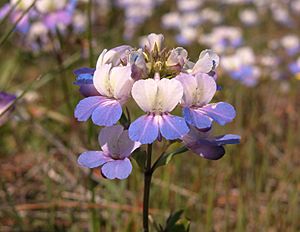Giant blue eyed Mary facts for kids
Quick facts for kids Giant blue eyed Mary |
|
|---|---|
 |
|
| Scientific classification | |
| Genus: |
Collinsia
|
| Species: |
grandiflora
|
Collinsia grandiflora is a beautiful wild flower often called giant blue eyed Mary or large-flowered collinsia. It belongs to the plantain family. This plant grows naturally in western North America. You can find it from British Columbia in Canada all the way down to northern California in the United States. It likes to grow in forests under coniferous trees and in woodland areas.
Discovering Giant Blue Eyed Mary
This plant is known for its pretty purple and white flowers. It's a type of plant that completes its whole life cycle in just one year. This means it grows from a seed, flowers, produces new seeds, and then dies, all within a single growing season.
What Does It Look Like?
The Collinsia grandiflora is a rather small plant. It usually grows straight up to about 35 centimeters tall. That's about the length of a standard ruler!
- Stems and Leaves: It has a thin stem and narrow leaves. When it's young, before it flowers, it can look a lot like grass.
- Flowers: The plant produces many flowers grouped together. This group of flowers is called an inflorescence. The flowers grow in separate levels, like a stack of small flower arrangements. Each level has a row of one or more flowers.
- Flower Details: Each flower looks a bit like a pea flower and is just over a centimeter wide. They are a bright purple color with white parts on the top, which look like "lips."
- Seeds: After the flowers bloom, they turn into a type of fruit called a capsule. This capsule is like a small pod that holds four seeds inside.
Why "Giant" and "Large-Flowered"?
Even though the plant itself is quite small, its common names include "giant" and "large-flowered." This is because its flowers and other features are bigger than those of most other plants in the Collinsia group. So, it's "giant" compared to its close relatives!

